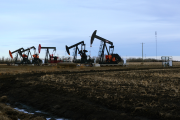The federal government is spending two years and $24 million in taxpayer dollars on an ad campaign to cast the oilsands industry as a world leader in “responsible resource development.” It’s a storyline echoed by oilsands proponents, who assert — as Margaret Wente did earlier this week — that oilsands production is governed by “some of the most stringent environmental regulations on the planet.”
Even if that were true — and unfortunately, it’s not — regulations can only save the day if they are enforced. Take a closer look at environmental management in the oilsands, and you’ll find too many cases where existing regulations are brushed off by oilsands operators, government agencies, or both.
Consider the management of tailings waste, a byproduct of oilsands mining. Tailings lakes currently cover 176 square kilometres of Northern Alberta (1.5 times the size of Vancouver) and are expected to continue growing as new mines are developed.
Recognizing this growing problem, in 2009 the government of Alberta introduced new requirements for cleaning up this toxic waste. It was a necessary and positive step, and an opportunity to show critics that the province was serious about improving environmental performance in the oilsands.
But since then, not a single oilsands company has met those provincial requirements — and the government backed down, saying it “does not believe that it would be appropriate to enforce compliance measures at this time.”
So even when rules exist, there is no guarantee they will be enforced.
This approach doesn’t just apply to tailings; a recent independent study found that Alberta enforces fewer than one per cent of potential environmental infractions committed by oilsands companies.
Alberta’s long-awaited wetlands policy is another example. Released this summer after seven years in the making, the policy exempts 195 oilsands projects from having to comply with the provincial rules. The Alberta government apparently felt it would be “onerous” and costly to ask companies to meet the new standards, despite an anticipated seven cents-a-barrel price tag. In a region dominated by wetlands — which are notoriously difficult, if not impossible, to reclaim once damaged — exempting oilsands companies from meeting laws designed to protect this fragile ecosystem seems completely counterintuitive.
Then there are the cases where no rules exist.
Denying these challenges, delaying regulation, and cutting industry slack in meeting existing rules isn’t helping sell the world on the responsible development story.According to Environment Canada’s latest data, oilsands emissions are projected to triple between 2005 and 2020, in the process wiping out all emission reductions expected from other sectors. This growth in oilsands emissions is the biggest barrier to meeting Canada’s international climate commitments — not to mention earning the social licence needed to get oilsands to market.
Yet Ottawa continues to put off releasing regulations that would address this issue. After two years of closed-door negotiations with the industry and Alberta, the federal government has yet to publish even the outlines of a proposal to curb emissions from Canada’s oil and gas sector.
So where does this leave us?
The challenges associated with improving environmental performance in the oilsands are significant, ranging from climate impacts to air quality issues, serious groundwater risks, dwindling caribou herds, First Nations legal challenges and failed regulatory processes.
Denying these challenges, delaying regulation, and cutting industry slack in meeting existing rules isn’t helping sell the world on the responsible development story.
Canada needs an oilsands debate that moves beyond who is ideologically for or against the industry, to one that takes a good hard look at the impacts of production today, and considers how much production may be too much.
Making responsible development a reality requires acknowledging where existing policies and practices are falling short, and embracing solutions. Enforcing existing rules and putting in place new ones that effectively raise the bar for environmental leadership seems a reasonable place to start.







